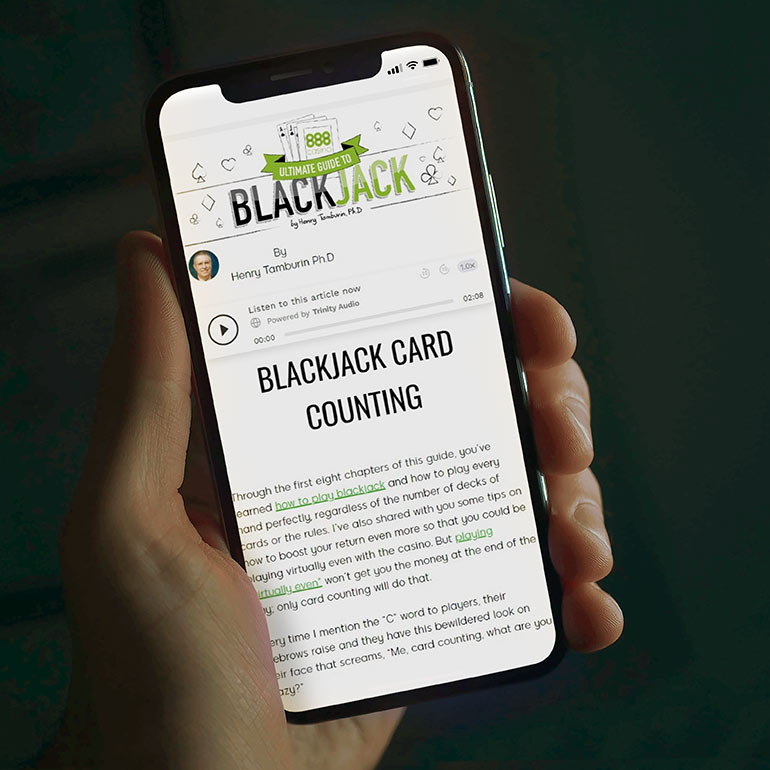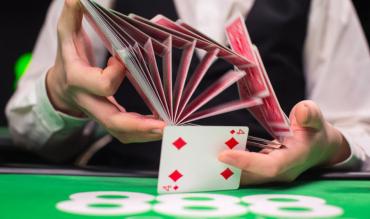I’ll bet you dollars to doughnuts that you have heard about the basic playing strategy and card counting in blackjack. However, I’ll bet the ranch that this isn’t the case with shuffle tracking. I’m about to change this.
Table of Contents
Note: I’m assuming you know the basic playing strategy and a little about card counting because shuffle tracking is an extension of both. I’ll also use the masculine “he” to refer to a card counter or shuffle tracker rather than the awkward “he or she.” (There are, in fact, some very good female counters and trackers.)
1. THEORY OF SHUFFLE TRACKING
A casino dealer cannot achieve a completely random shuffle of four or more decks of cards in a reasonable time. By seeing a lot of tens and aces on the felt in a round of play, shuffle trackers watch where these clumps (or zones) of high cards are placed in the discard tray.
They then watch where they end up after the shuffle, then cut the zone to the top of the shuffled stack of cards and bet big when they dealt.
2. WHAT’S INVOLVED?
Here’s an example of a technique that shuffle trackers use to track the unplayed cards in a six-deck shoe game. I used this when I started Shuffle Tracking.
Suppose a shuffle tracker is card counting a six-deck game, and after four and a half decks are played, the cut (or shuffle) card comes out of the shoe. Let’s assume he has a very positive count at this point. What the latter tells him is that the clump of unplayed cards located behind the cut card must contain a high concentration of tens and aces.
What he does is carefully track this clump through the dealer’s shuffling procedure so that he can predict, with a fair amount of certainty, where this clump of high cards is located in the freshly shuffled stack of cards. He then places the cut card directly above this clump or zone of high cards so that it ends up at the top of the stack of cards.
After the dealer places the shuffled stack into the dealing shoe, he knows that the first zone of cards that will be dealt from the shoe contains an excess of high cards. Therefore, he will make large bets at the start of the round (and usually play multiple spots).
OK, now that you have the gist of shuffle tracking, let’s get into the nuts and bolts on what a shuffle tracker must learn and do to be successful at this skill.
- He has to know the shuffling routine that the dealers are using in a casino.
- He has to simulate this shuffle at home to know exactly where the zone of high cards ends up after the shuffle. This is known as “mapping the shuffle.”
- He has to control the positioning of the cut card into the shuffled stack of cards.
Let’s examine each of the above in more detail.
3. CASINOS’ SHUFFLING ROUTINE
There are several different types of shuffling procedures used by casinos. Below is an example from the late Vinny DeCarlo, who was a casino dealer and floor supervisor, worked in casino surveillance, and was a skilled card counter. He also contributed articles to my Blackjack Insider newsletter, and authored the virtual book, How to Beat Casino Surveillance.
“The dealer removes the cards from the discard tray and separates the six decks into three piles on the layout. She starts the shuffling process by picking about a deck’s worth of cards (a grab) from pile one (far left), and a pile (grab) from pile three (far right). She marries these two grabs by riffling them at least twice, adding a strip (i.e., peeling off the top cards of a grab and sending them to the bottom of the grab/stack), and then another riffle (i.e., the act of joining two grabs together, aka a shuffle).
“She then grabs a deck’s worth from the middle pile and riffles them with the new stack. From there it’s random grabs and swaps (pulling cards randomly from the full stack of shuffled cards and riffling them together with added strips).”
After reading the above, I’m sure your first thought is shuffle tracking is impossible. However, that’s not the case, although it is a difficult skill to master. It is possible with plenty of practice to track a target zone of cards through the shuffling to predict where they will be located in the shuffled stack of cards.
The key to doing this accurately is to practice the casino’s shuffling procedure and map it at home. There are tools to help you. Blackjack Hall of Famer Arnold Snyder wrote the classic book on shuffle tracking, The Blackjack Shuffle Tracker’s Cookbook. Additionally, Vinny DeCarlo’s article, published in the Blackjack Insider newsletter, contains a technique using six decks of cards and two different colored Sharpie Markers to practice mapping.
You’ll also find information on shuffle tracking in Bill Zender’s book, Advantage Play for the Casino Executive. Lastly, the popular Casino Vérité blackjack software program has a shuffle-tracking module.
4. CUTTING THE SHUFFLED CARDS
The key to gaining the edge at shuffle tracking is to get control of the cut card so that you cut off everything that isn’t in your ten-rich zone and the first cards out of the shoe will be the player-favorable high cards. If you are playing heads up against a dealer, it’s a no-brainer when it comes to controlling the cut.
However, when other players are present, it becomes a crapshoot if they receive the cut card. You can ask the player if you can cut instead by saying something along the lines of, “I’m always lucky and win when I cut.” However, the better solution, and the one used by the majority of professional shuffle trackers, is to have a team of players on the table so that one of them will be able to control the cut.
5. PLAYING AND BETTING
A shuffle tracker who has accurately cut a ten-rich deck to the top of the shuffled stack of cards will immediately make a large bet on the first round. Often he will play more than one spot with large bets. He will continue to make large bets until the ten-rich zone has been depleted. He will also use a modified playing strategy for hitting, standing, doubling down, and pair splitting to take advantage of the 10-rich zone.
6. PROS OF SHUFFLE TRACKING
- Shuffle trackers can achieve advantages much greater than card counting.
- Making large bets immediately after the shuffle is great camouflage since card counters usually must wait until several decks have been played before they increase their bets.
- The bet spreads can be much greater than what a card counter can get away with.
7. CONS OF SHUFFLE TRACKING
- You must be an accurate card counter.
- It is a much more difficult skill to master than card counting. Shuffle trackers must be highly accurate in their estimates of where the zone of ten-rich cards is located and their control of the cut card.
- Often shuffle trackers lose money in the short run as they begin to track shuffles in the casino. Making mistakes in knowing where the exact location of the ten-rich zone can be costly to a shuffle tracker.
- You need to locate a casino that uses a relatively simple casino shuffling procedure.
- Even if you find a casino with a simple shuffling procedure, they can change it on a whim.
- Unlike card counting, shuffle tracking is not an exact science.
8. CASINO COUNTERMEASURES
Casinos have not sat by idly once they learned about shuffle tracking (and how much shuffle trackers were taking from their coffers). Here are some of the measures they have taken to thwart shuffle tracking:
- The dealer will “plug” the cards that have not been played into the stack of “played” cards at various random areas.
- They implemented a more “complex” shuffling routine to ensure that the cards are more randomly mixed in a reasonable amount of time.
- They periodically change their shuffling procedures.
- They implemented automatic and continuous shuffling machines.

9. CAMOUFLAGE
Firing away with big bets on the first round after a shuffle often confuses casino supervisors. However, doing it consistently and winning money will draw attention your way.
The best techniques to disguise the fact that you are shuffle tracking are contained in the book, Radical Blackjack by Arnold Snyder. He and his wife Radar won a ton of money at shuffle tracking, and the details of their playing trips, including the camouflage that they use, are revealed in his book. This is a must-read if you plan on pursuing shuffle tracking.
10. CARD COUNTING VS. SHUFFLE TRACKING
Below is a table that compares the characteristics of Card Counting vs. Shuffle Tracking
| CHARACTERISTIC | CARD COUNTING | SHUFFLE TRACKING |
| Increasing Bets | Rarely after the shuffle | Usually after the shuffle |
| Number of Decks of Cards | 1, 2, 4, 6, or 8 | 6 or 8 |
| Bet Spread Six-Deck Game | 1 to 12 | Can be much greater than 1-12 |
| Level of Difficulty | Moderate | Very High |
| Team Play | Yes | Yes |
| Precision in Strategy Implementation | Low-Medium | Very High |
| Percent Advantage | 0.5% - 1.5% | Can be much greater than 1.5% |
| Exact Science | Yes | No |
11. ONLINE BLACKJACK GAMES
Sorry, but you can’t shuffle track a blackjack game in an online casino because the cards are shuffled by a random number generator after every round.
12. OTHER CARDS TO TRACK
Besides tracking ten-rich zones, shuffle trackers sometimes track zones rich in low cards and cut them out of play. Another technique similar to shuffle tracking is called ace sequencing, where a player watches where the aces go into the discard tray, follows them through the shuffle and controls the cut so the ace is the first card dealt from a shoe.
13. SUMMARY
- Shuffle tracking is an advanced playing technique that involves knowing when slugs of high cards are placed into the stack of cards. Trackers then follow this zone through the shuffle so that you know where the zone ends up in the shuffled stack of cards.
- A shuffle tracker must then control the placement of the cut card so that he will know with a great amount of certainty when this zone will be dealt from the shoe.
- He then fires away with big bets in a ten-rich zone, which allows him to gain a sizable advantage over the casino.
- This skill requires a great deal of practice and works best with a team of players.
- Shuffle tracking does not work with automatic or continuous shufflers or in online blackjack games.
- It works best when a casino uses a relatively simple, manual casino shuffling procedure.
- A player must be proficient in the basic playing strategy and card counting before attempting to learn and use shuffle tracking.
